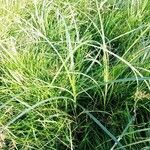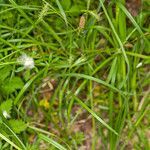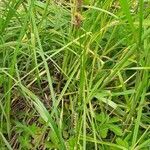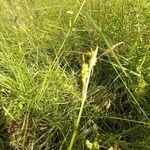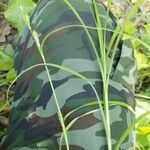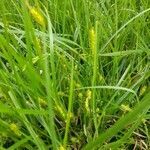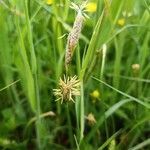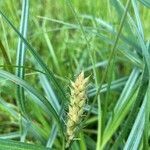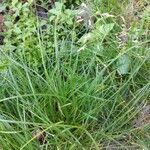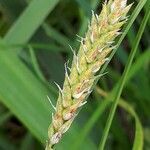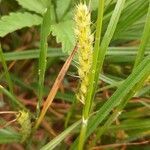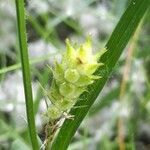Culms trigonous in cross section, (10–)20–90 cm. Leaves: basal sheaths brown, reddish purple tinged, inner bands slightly fibrillose with age; sheaths spreading pubescent; ligules 2–8(–10.5) mm; blades spreading, 2.5–8 mm wide, pubescent, not papillose abaxially. Inflorescences 8–50 cm; spikes erect or ascending; proximal (1–)2–3 spikes pistillate; terminal 1–3 spikes staminate. Pistillate scales ovate, apex acute to acuminate, scabrous-awned, sparsely spreading-pubescent or glabrous. Staminate scales ovate, apex obtuse to acuminate, shortly scabrous-awned except sometimes the proximal, sparsely to densely spreading-white-pubescent. Perigynia 12–20-veined, 4.8–7.8 × 1.7–2.5 mm, ± densely spreading-pubescent; beak 1.5–2.7 mm, spreading-pubescent, teeth spreading, 0.8–1.7 mm. 2n = 112–114.
Vigorously colonial by creeping rhizomes; aphyllopodic, 3–10 dm; sheaths hairy at the mouth and usually on the back; main lvs 3–6 mm wide, often sparsely hairy; staminate spikes 1–3, 2–3 cm, only the upper one peduncled; pistillate spikes 2–3, widely separated, cylindric, 2–5 cm, densely fld, erect, short-peduncled; bracts lf-like, short-spreading at base, often surpassing the stem; pistillate scales lance-ovate, half to fully as long as the perigynia, usually sparsely villous, acute to acuminate or awned; perigynia narrowly ovoid, 5–8 mm, hairy, conspicuously nerved, acuminately tapering into a beak over half as long as the body, its divergent teeth 1–1.5 mm; achene trigonous. Native of Europe, intr. in waste places and dry fields from P.E.I. to Wis. and D.C.
A sedge. These grow in clumps and have grass like leaves and solid stalks.
